
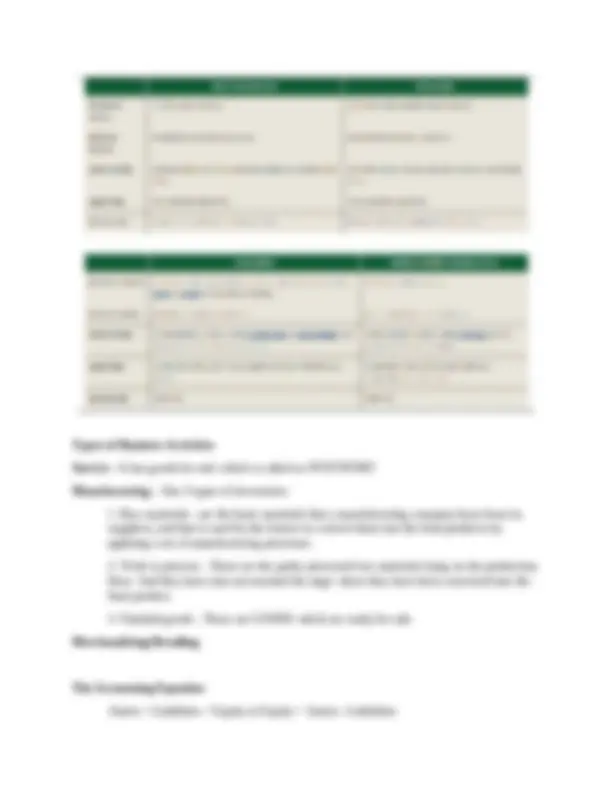
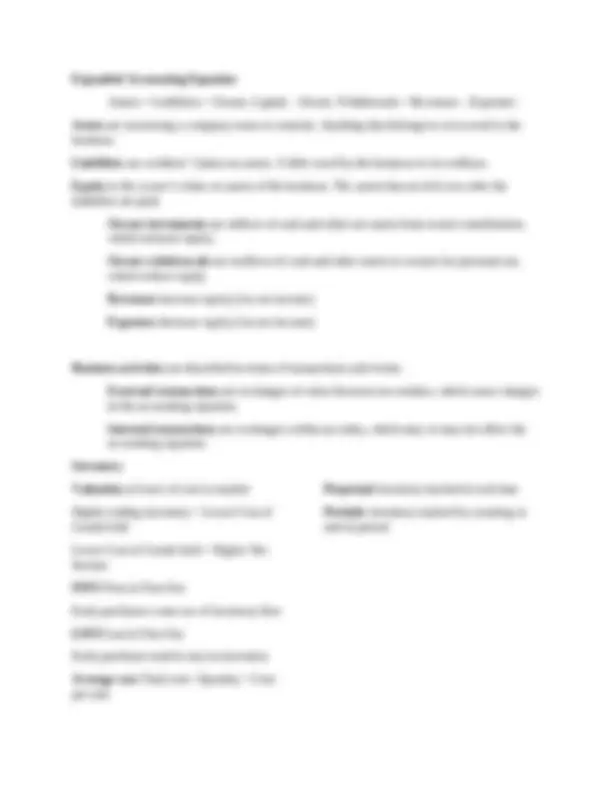
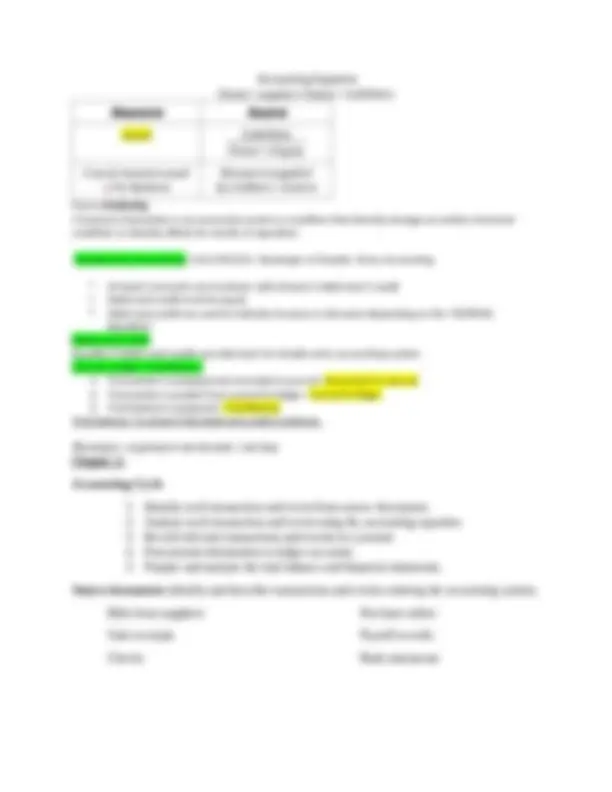
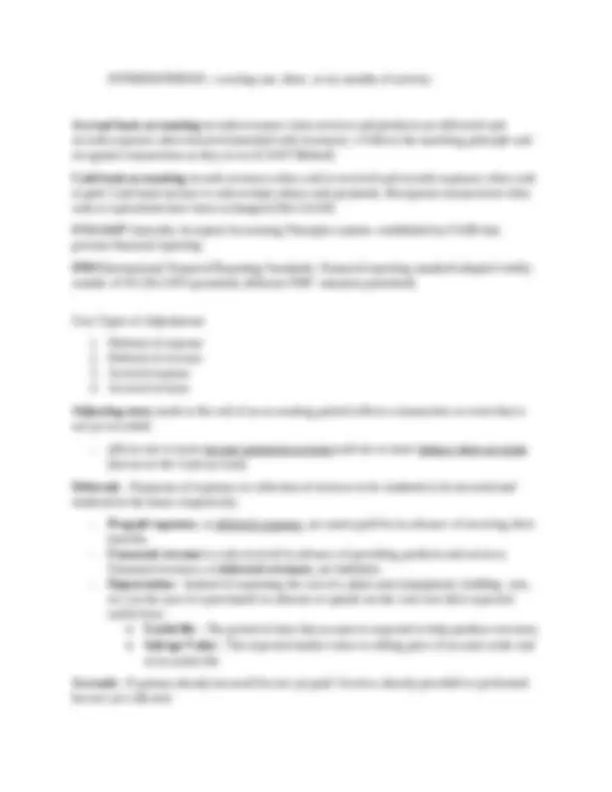
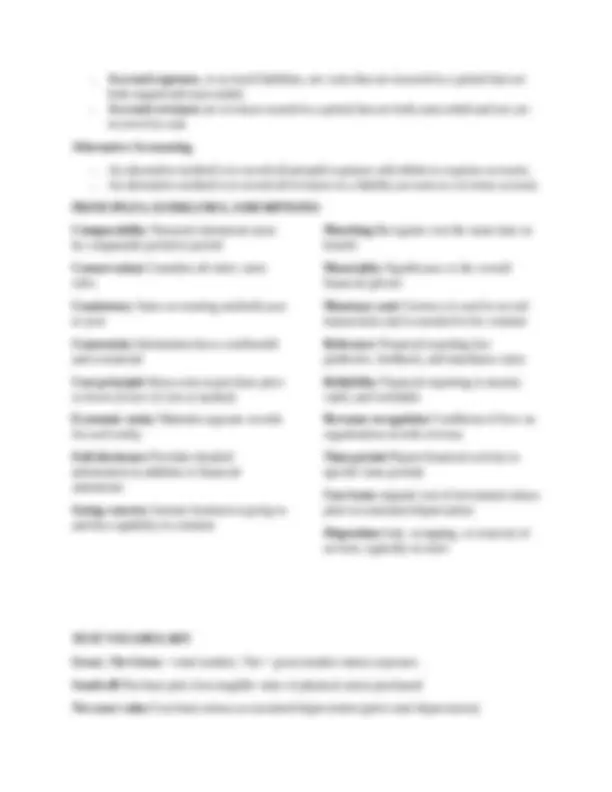
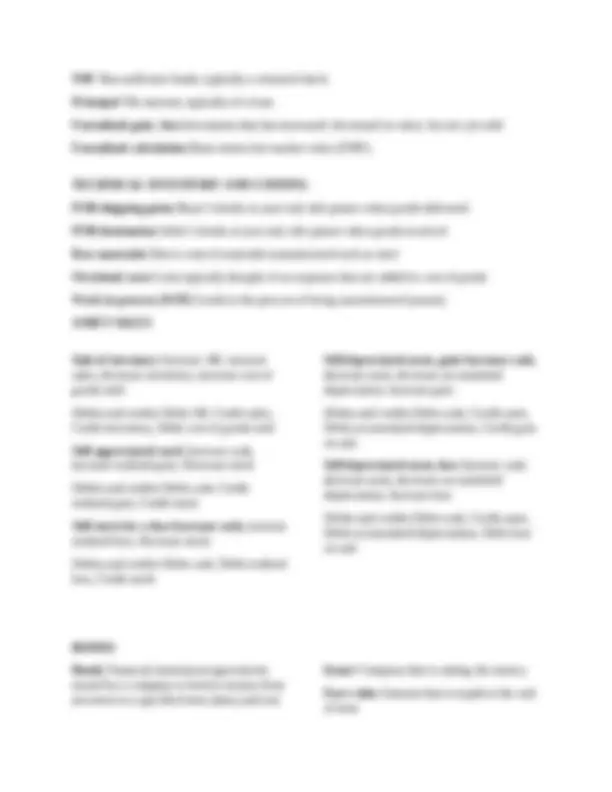
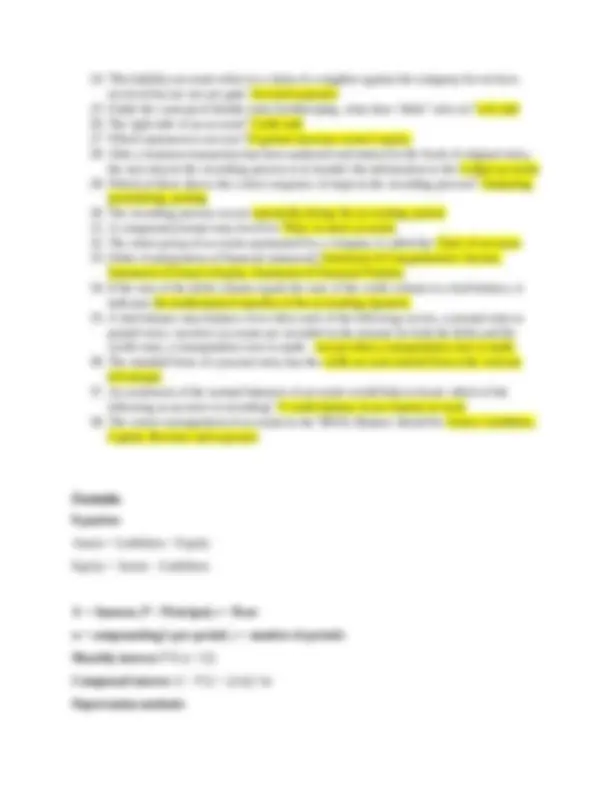
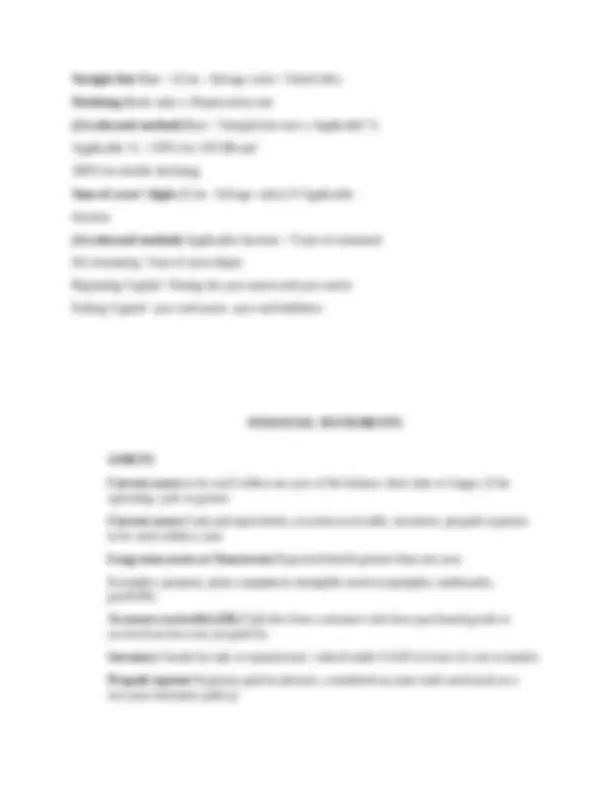
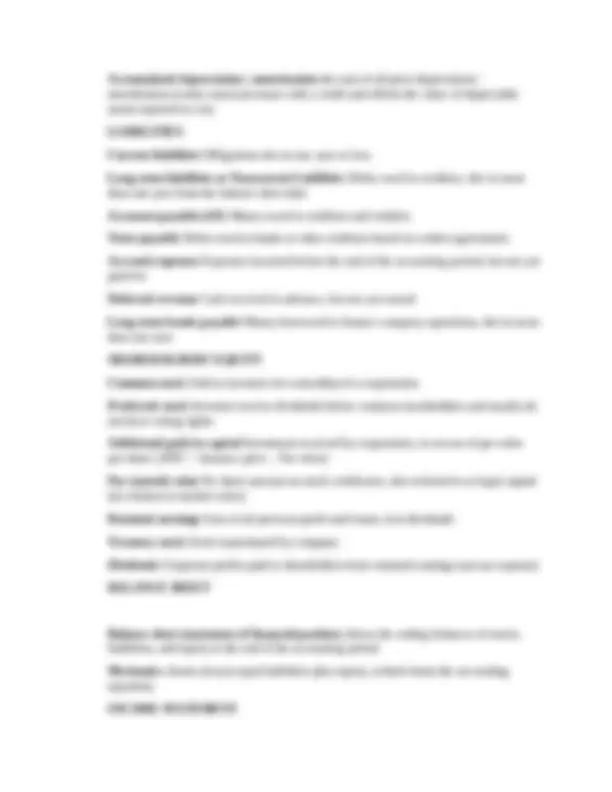


Study with the several resources on Docsity

Earn points by helping other students or get them with a premium plan


Prepare for your exams
Study with the several resources on Docsity

Earn points to download
Earn points by helping other students or get them with a premium plan
Community
Ask the community for help and clear up your study doubts
Discover the best universities in your country according to Docsity users
Free resources
Download our free guides on studying techniques, anxiety management strategies, and thesis advice from Docsity tutors
1st year Fundamental of Accountancy
Typology: Study notes
Uploaded on 11/29/2021
5
(1)2 documents
1 / 17

This page cannot be seen from the preview
Don't miss anything!










Chapter 1: Accounting is an information and measurement system that identifies, records, and communicates an organization’s business activities.
Expense recognition principle (matching principle) - A company records the expenses it incurred to generate the revenue reported. Accounting Assumptions Going-concern assumption. Presumes that the business will continue operating instead of being closed or sold. Monetary unit assumption. Transactions and events are expressed in monetary, or money, units. Time period assumption. The life of a company can be divided into time periods, such as months and years, and useful reports can be prepared for those periods. Business entity assumption. A business is accounted for separately from other business entities and its owner. Accounting Constraints Cost benefit constraint. Only information with benefits of disclosure greater than their cost need to be disclosed Materiality constraint. Only information that would influence the decisions of a reasonable person need to be disclosed. Accounting Concepts and Principles: The Entity Concept - An organization is a separate entity from the owner(s) of the organization. The Reliability (Objectivity) Principle - Accounting records and statements should be based on the most reliable data available so that they will be as accurate and useful as possible. The Cost Principle - Acquired assets and services should be recorded at their actual cost not at what they are believed to be worth. The Going-Concern Concept - The assumption that the business will continue operationing for the foreseeable future. The Stable-Monetary Unit Concept - Accounting transaction are recorded in the monetary unit used in the country where the business is located
Expanded Accounting Equation Assets = Liabilities + Owner, Capital – Owner, Withdrawals + Revenues – Expenses Assets are resourcing a company owns or controls. Anything that belongs to or is owed to the business. Liabilities are creditors’ claims on assets. A debt owed by the business to its creditors. Equity is the owner’s claim on assets of the business. The assets that are left over after the liabilities are paid. Owner investments are inflows of cash and other net assets from owner contributions, which increase equity. Owner withdrawals are outflows of cash and other assets to owners for personal use, which reduce equity. Revenues increase equity (via net income) Expenses decrease equity (via net income) Business activities are described in terms of transactions and events. External transactions are exchanges of value between two entities, which cause changes in the accounting equation. Internal transactions are exchanges within an entity, which may or may not affect the accounting equation. Inventory Valuation at lower of cost or market Higher ending inventory = Lower Cost of Goods Sold Lower Cost of Goods Sold = Higher Net Income FIFO First in First Out Early purchases come out of inventory first LIFO Last in First Out Early purchases tend to stay in inventory Average cost Total cost / Quantity = Cost per unit Perpetual inventory tracked in real time Periodic inventory tracked by counting at end of period
Accounting Equation Owne r ' s equity = Assets − Liabilities Resource Source Asset Liabilities Owne r ' s Equity Cost of resources used ¿ t h e business Resources supplied by creditors ∧ owners First is Analyzing A business transaction is an economics event or condition that directly changes an entity's financial condition or directly affects its results of operation. Double Entry Accounting- LUCA PACIOLI- Developer of Double- Entry Accounting (^) At least 2 accounts are involved, with at least 1 debit and 1 credit (^) Debit and credit must be equal (^) Debit and credit are used to indicate increase or decrease depending on the "NORMAL BALANCE" Debits and Credit Equality if debits and credits provide basis for double entry accounting system. Journal, Ledger, Trial Balance
Ledger is a collection of all accounts and their balances for an accounting system.
INTERIM PERIOD - covering one, three, or six months of activity. Accrual basis accounting records revenues when services and products are delivered and records expenses when incurred (matched with revenues). s Follows the matching principle and recognizes transactions as they occur (GAAP Method) Cash basis accounting records revenues when cash is received and records expenses when cash is paid. Cash basis income is cash receipts minus cash payments. Recognizes transactions when cash or equivalents have been exchanged (Not GAAP) US-GAAP Generally Accepted Accounting Principles system- established by FASB that governs financial reporting IFRS International Financial Reporting Standards- Financial reporting standard adopted widely outside of US (No LIFO permitted, different FMV valuation permitted) Four Types of Adjustments
NSF Non-sufficient funds, typically a returned check Principal The amount, typically of a loan Unrealized gain | loss Investment that has increased | decreased in value, but not yet sold Unrealized calculation Basis minus fair market value (FMV) TECHNICAL INVENTORY AND COSTING FOB shipping point Buyer’s books at year end, title passes when goods delivered FOB destination Seller’s books at year end, title passes when goods received Raw materials Direct costs of materials manufactured such as steel Overhead costs Costs typically thought of as expenses that are added to cost of goods Work in process (WIP) Goods in the process of being manufactured (assets) ASSET SALES Sale of inventory Increase AR, increase sales, decrease inventory, increase cost of goods sold Debits and credits Debit AR, Credit sales, Credit inventory, Debit cost of goods sold Sell appreciated stock Increase cash, increase realized gain, Decrease stock Debits and credits Debit cash, Credit realized gain, Credit stock Sell stock for a loss Increase cash, increase realized loss, Decrease stock Debits and credits Debit cash, Debit realized loss, Credit stock Sell depreciated asset, gain Increase cash, decrease asset, decrease accumulated depreciation, Increase gain Debits and credits Debit cash, Credit asset, Debit accumulated depreciation, Credit gain on sale Sell depreciated asset, loss Increase cash, decrease asset, decrease accumulated depreciation, Increase loss Debits and credits Debit cash, Credit asset, Debit accumulated depreciation, Debit loss on sale BONDS Bonds Financial instrument (agreement) issued by a company to borrow money from investors at a specified term (time) and rate Issuer Company that is raising the money Face value Amount that is repaid at the end of term
Stated coupon rate Interest that bond pays investor Effective interest Rate of interest investor receives if the bond is purchased at a discount or premium Premium Amount company is paid in excess of face value, often paid when coupon rate is greater than market rate Premium = Price paid for bond - face value Discount Amount below the face value paid for a bond often occurs when coupon rate is less than market rate Discount = Face value - price paid for bond Depreciation terms Cost Price paid for asset (may include costs to install) Book value Cost - Accumulated depreciation Salvage value Estimated scrap value at the end of asset life Accelerated methods Methods resulting in greater depreciation during earlier years MACRS / ACRS / DDB Accelerated depreciation methods Depreciation Expense taken on a physical asset over time Amortization Expense taken on an intangible asset over time
Straight line Rate = (Cost - Salvage value / Useful life) Declining Book value x Depreciation rate (Accelerated method) Rate = Straight line rate x Applicable % Applicable % = 150% for 150 DB and 200% for double declining Sum-of-years’-digits (Cost - Salvage value) X Applicable fraction (Accelerated method) Applicable fraction = Years of estimated life remaining / Sum of years digits Beginning Capital= During the year assets-end year assets Ending Capital= year end assets- year end liabilities FINANCIAL STATEMENTS ASSETS Current assets to be used within one year of the balance sheet date or longer, if the operating cycle is greater Current assets Cash and equivalents, accounts receivable, inventory, prepaid expenses to be used within a year Long-term assets or Noncurrent Expected benefit greater than one year Examples: property, plant, equipment, intangible assets (copyrights, trademarks, goodwill) Accounts receivable (AR) Cash due from customers who have purchased goods or received services not yet paid for Inventory Goods for sale or manufacture, valued under GAAP at lower of cost or market Prepaid expense Expenses paid in advance, considered an asset until used (such as a two-year insurance policy)
Income statement (profit and loss) shows the performance of a business by reporting revenue earned minus expenses incurred to equal net income or loss (profit or loss) Mechanics Reports the business activity for a specific period of time and results in net income or loss, which gets recorded to retained earnings at the end of the accounting period REVENUE AND EXPENSE Revenue recognition Recognize (book into accounting record) revenue when it is earned and realizable Expense recognition Expenses are recognized when incurred, as goods are used and services received Net income or loss Revenue minus expenses results in net income or net loss also referred to as profit or loss Net income increases retained earnings and net loss decreases retained earnings STATEMENT OF CASH FLOWS Debit- Inflow Credit-Outflow Statement of cash flows Shows the flow of cash in and out of the business Mechanics Starts with beginning cash from the prior period and reconciles to ending cash in the current period showing the changes Usefulness Shows actual changes in cash on a cash basis, instead of the accrual basis which does not necessarily reflect the flow of cash Indirect method of preparation uses the changes in accrual basis accounts Direct method of preparation (uncommon) presents specific cash flows such as cash received from customers and paid to suppliers Operating Activities Cash Inflows- sale of goods and service performed, from royalties, fees, commissions and ither revenues Cash Outflows- payments to suppliers of goods and services, employees, taxes, interest expense other operation expenses. Investing Activities Cash Inflows - sales of property and equipment, investments in debt or equity securities, collection on notes receivable in investment
Cash Outflows - payments to acquire property and equipment, acquire debt or equity securities, notes receivable in investment. Financing Activities Cash Inflows- investments by owners, issuance of notes payable in financing Cash Outflows- payment to owners in the form of withdrawals, settle notes payable financing STATEMENT OF OWNERS’ EQUITY Statement of owners' equity shows sources of capital (business funding), additional paid in capital and common stock breakdown, changes in retained earnings, and treasury stock (stock repurchased) Mechanics The statement starts with beginning balances and reconciles to ending period balance